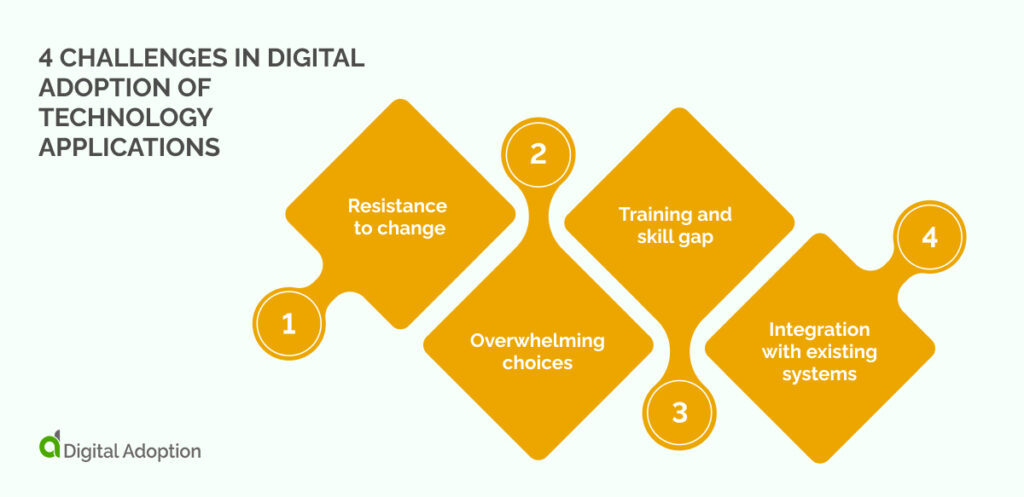Technology applications drive business growth by streamlining operations, enhancing efficiency, and improving customer experiences. They automate tasks, analyze data, and facilitate communication, leading to increased employee productivity.
These digital tools provide insights into market trends and business performance, enabling strategic decision-making and offering a competitive edge.
Technology has always been a driving force in human progress.
From the invention of the wheel to the latest AI innovations, each leap has fundamentally changed the way we live, work, and interact.
In recent years, we’ve seen an unprecedented acceleration in technological advancements, shaping every facet of our lives.
You might have come across the term “technology applications” quite often. But what does it really mean?
A technology application is a tailored software or tool crafted to address a specific business challenge or need. It could be a homegrown CRM system streamlining your sales processes or the bespoke AI algorithm predicting market trends.
These technology applications aren’t mere luxuries but imperatives in our modern competitive landscape, instrumental in scaling, optimizing, and ensuring resilience. In a recent survey, Deloitte found that companies with higher digital maturity reported 45% revenue growth in FY19.
As we navigate this discourse, we’ll explore the significance of these applications and their pivotal role in achieving robust digital adoption for a future-proof business.
Understanding technology applications is the first step in leveraging digital technology to boost your business.
- Types of technology applications
- The connection between technology applications and digital adoption
- 4 key benefits of technology applications
- 4 challenges in digital adoption of technology applications
- 4 critical strategies to help you overcome technology application challenges
- Technology applications: The backbone of modern business
Types of technology applications

Recognizing and harnessing the right technology applications can be the difference between leading the pack and playing catch-up in today’s dynamic business world.
The digital landscape is rife with examples of technology applications.
You’ve got mobile apps enhancing customer engagement, SaaS platforms revolutionizing business operations, and a plethora of digital tools and utilities that refine tasks and boost efficiency.
Let’s break down a few of the different types of technology applications you should be familiar with.
Consumer applications
These are the platforms your customers engage with daily.
Think of social media apps that shape consumer behaviors or gaming software that captivates audiences and creates brand interactions.
Enterprise applications
Vital for business leaders, these are the engines behind the scenes.
Systems like ERP streamline operations, CRMs that optimize customer relationships, or cloud storage solutions that safeguard and centralize your business data.
Specialized applications
Tailored for niche needs, these applications cater to specific industries or tasks.
This category includes software like medical imaging tools that revolutionize healthcare diagnostics or architectural design software that empowers architects to visualize and realize their projects.
The connection between technology applications and digital adoption

In a competitive business landscape, merely possessing tools isn’t enough.
It’s about integrating and mastering these tools to drive tangible results.
Herein lies the essence of the relationship between technology applications and digital adoption.
Defining digital adoption
Digital adoption is a strategic imperative for business leaders.
It describes the stage where your organization doesn’t just use technology applications but leverages them to their absolute potential.
When achieved, your teams are not merely operating tools but optimizing processes, enhancing efficiency, and supercharging your business objectives.
Technology applications as catalysts
How exactly do technology applications underpin robust digital adoption?
Bridging the gap between users and digital tools: These applications are meticulously designed with end-users in mind, serving as translators of the digital language.
They convert the immense potential of digital processes into tangible, actionable business outcomes.
This ensures that even the most sophisticated digital solutions become accessible and actionable for every member of your team.
Simplifying complex tasks through intuitive interfaces: Modern technology applications prioritize customer experience above all.
They break down complex digital operations into intuitive, manageable tasks.
This customer-centric design ensures that your team accesses a tool’s features and fully harnesses its capabilities, promoting genuine digital adoption.
In a nutshell, technology applications transcend their role as mere tools. They are the bridge to a digitally proficient and future-ready organization.
4 key benefits of technology applications

It’s crucial to understand not just what technology applications offer but the tangible benefits they can bring to the table.
Here are 4 standout advantages that should be on your radar:
1. Increased efficiency
The heart of any successful business operation is efficiency. Technology applications enable this by automating repetitive tasks and refining processes.
The result?
Tasks that once took hours can now be executed in minutes, and teams can focus on more strategic endeavors rather than getting bogged down in manual operations.
2. Improved user experience
In the digital age, the end-user experience can make or break your business’s reputation and bottom line. A Forrester report found that “becoming an experienced business” can deliver 1.4x revenue growth, 1.7x customer retention rates, and 1.6x customer lifetime value.
Technology applications prioritize this by offering sleek user interfaces, ensuring easier access to tools and features, and paving a more intuitive learning path.
This not only enhances customer satisfaction but also ensures your team interacts with tools seamlessly.
3. Better decision-making
Informed decisions are the backbone of strategic leadership.
With technology applications, you’re granted access to real-time data and insightful analytics.
This means you’re no longer shooting in the dark; every decision is backed by concrete data, ensuring you’re always a step ahead in the market.
4. Cost reduction
While the initial investment in technology applications might seem significant, the long-term cost savings are undeniable.
By reducing the need for extensive employee training, cutting down on manual processes, and minimizing errors, these tools ensure your financial resources are allocated where they’re most impactful.
4 challenges in digital adoption of technology applications

While the advantages of technology applications are substantial, the road to full digital adoption can be riddled with obstacles.
Recognizing these challenges early on allows you to strategize solutions, ensuring a smoother transition.
Here are the 4 key hurdles you might encounter:
1. Resistance to change
Humans are creatures of habit.
Employees often gravitate towards familiar processes and tools, even if they’re outdated.
This intrinsic resistance can hinder the adoption of newer, more efficient technology applications, making the transition process more prolonged and challenging.
2. Overwhelming choices
The technology landscape is vast and ever-evolving.
With a plethora of technology applications available, users can often feel overwhelmed, leading to decision paralysis.
Selecting the right tool that aligns with your business needs while being user-friendly is daunting.
3. Training and skill gap
Implementing a new technology application doesn’t automatically translate to its effective use.
It’s critical to ensure your team possesses the skills and knowledge to harness these tools to their full potential.
Addressing this training and skill gap is pivotal to avoid underutilization and ensure ROI.
4. Integration with existing systems
Businesses don’t operate in isolation; they already have a mesh of systems and processes.
Introducing a new technology application into this mix requires compatibility and integration smoothly with existing systems.
This is essential for maintaining operational cohesion.
4 critical strategies to help you overcome technology application challenges

To successfully navigate the complex landscape of technology applications, you must have proactive strategies.
We’ve got 4 effective strategies for you to consider.
Armed with these strategies, you can pave a smoother path to digital adoption, ensuring that technology applications deliver on their promise of driving business growth and efficiency.
1. Training and onboarding
The foundation of any successful digital adoption lies in equipping your team with the right skills.
This means going beyond simple introductions and offering comprehensive training sessions that cover the nuances of the new technology application.
A robust onboarding process ensures users can comfortably navigate and exploit the tool from day one.
2. User feedback and iteration
No tool is perfect, and user experiences can offer invaluable insights.
Create feedback loops that allow users to share their experiences, challenges, and recommendations.
This helps identify pain points and ensures continuous improvement of the application, aligning it even more closely with users’ needs.
3. Ensuring interoperability
In a business ecosystem, standalone solutions are rare.
Your technology applications need to operate in tandem with others.
Ensure that the new tools you introduce are designed or customized to work harmoniously with existing systems, preventing disruption and ensuring a unified digital experience.
4. Stakeholder buy-in
Digital adoption isn’t merely a bottom-up process.
Having the endorsement and active support of top management and key stakeholders can significantly expedite the adoption journey.
When leaders champion the cause, it creates a positive ripple effect, encouraging the entire organization to embrace the new technology applications wholeheartedly.
Technology applications: The backbone of modern business
In an age defined by rapid technological advances and digital transformation, technology applications have emerged as both the vanguard and backbone of modern businesses.
Yet, merely possessing these tools isn’t the endgame.
The true value of technology applications lies in holistic digital adoption, where every feature, every nuance of a technology application, is leveraged to its fullest potential.
By doing so, you stand to optimize your current operations and anticipate and shape future trends.













